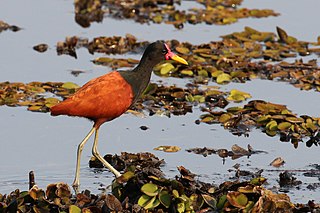
The wattled jacana is a wader which is a resident breeder from western Panama and Trinidad south through most of South America east of the Andes.

The Australian king parrot is a species of parrot endemic to eastern Australia ranging from Cooktown in Queensland to Port Campbell in Victoria. Found in humid and heavily forested upland regions of the eastern portion of the continent, including eucalyptus wooded areas in and directly adjacent to subtropical and temperate rainforest. They feed on fruits and seeds gathered from trees or on the ground.
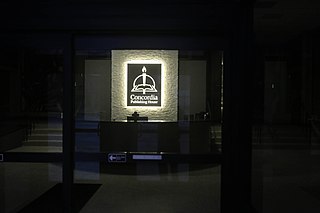
Concordia Publishing House (CPH), founded in 1869, is the official publishing arm of the Lutheran Church–Missouri Synod (LCMS). Headquartered in St Louis, Missouri, at 3558 S. Jefferson Avenue, CPH publishes the synod's official monthly magazine, The Lutheran Witness, and the synod's hymnals, including The Lutheran Hymnal (1941), Lutheran Worship (1982), and Lutheran Service Book (2006). It publishes a wide range of resources for churches, schools, and homes and is the publisher of the world's most widely circulated daily devotional resource, Portals of Prayer. Its children's books, known as Arch Books, have been published in millions of copies. Concordia Publishing House is the oldest publishing company west of the Mississippi River and the world's largest distinctly Lutheran publishing house.
Powassan virus (POWV) is a Flavivirus transmitted by ticks, found in North America and in the Russian Far East. It is named after the town of Powassan, Ontario, where it was identified in a young boy who eventually died from it. It can cause encephalitis, an infection of the brain. No approved vaccine or antiviral drug exists. Prevention of tick bites is the best precaution.
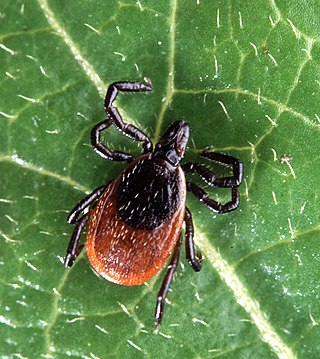
Ixodes scapularis is commonly known as the deer tick or black-legged tick, and in some parts of the US as the bear tick. It was also named Ixodes dammini until it was shown to be the same species in 1993. It is a hard-bodied tick found in the eastern and northern Midwest of the United States as well as in southeastern Canada. It is a vector for several diseases of animals, including humans and is known as the deer tick owing to its habit of parasitizing the white-tailed deer. It is also known to parasitize mice, lizards, migratory birds, etc. especially while the tick is in the larval or nymphal stage.

Hygrotus is a genus of beetle in family Dytiscidae. It contains two subgenera and about 70 species, including:

Zabrus is a genus of ground beetles. They are, unusually for ground beetles, omnivores or even herbivores, and Zabrus tenebrioides can become a pest in cereal fields.

Cymindis is a genus of ground beetle native to the Palearctic, the Near East, and North Africa. It contains the following species:
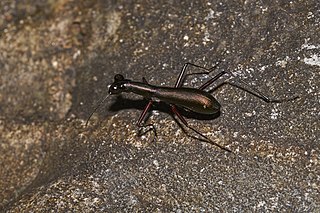
Tricondyla is a genus of tiger beetle, containing the following species:
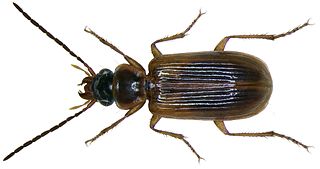
Anthracus is a genus of beetles in the family Carabidae, containing the following species:
Microdaccus is a genus of beetles in the family Carabidae, containing the following species:
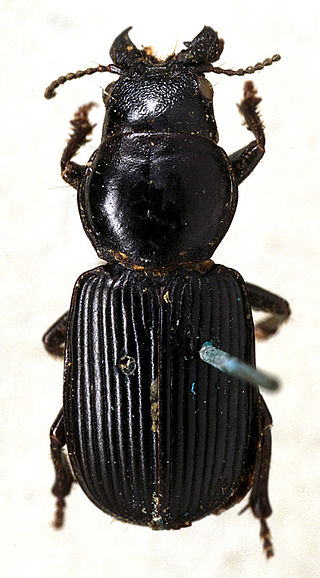
Orthogoniinae is a subfamily of ground beetles. Occasionally it was treated as a tribe Orthogoniini of subfamily Harpalinae, particularly when this was circumscribed loosely.

Osteochilus is a genus of cyprinid fishes mainly found in Southeast Asia with a few extending into adjacent parts of China. Additionally, two species are endemic to the Western Ghats in India.
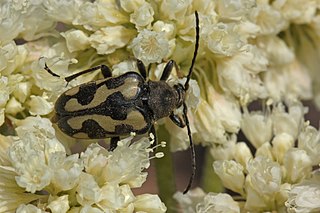
Judolia is a genus of beetles in the family Cerambycidae, containing the following species:
Cymindis maderae is a species of ground beetle in the subfamily Harpalinae. It was described by Thomas Vernon Wollaston in 1857.
Dyschirius bacillus is a species of ground beetle in the subfamily Scaritinae. It was described by Hermann Rudolph Schaum in 1857.
Dyschirius importunus is a species of ground beetle in the subfamily Scaritinae. It was described by Schaum in 1857.

Lebiini is a tribe of ground beetles in the family Carabidae. There are more than 250 genera and 4,800 described species in Lebiini.

Cremastocheilini is a tribe of scarab beetles in the family Scarabaeidae. There are over 40 genera in the tribe Cremastocheilini.












